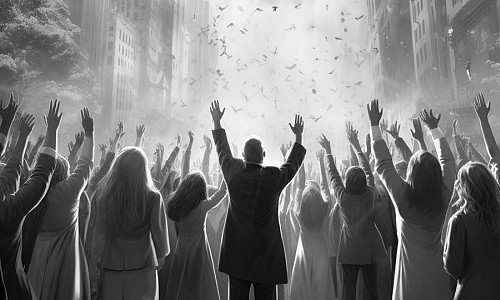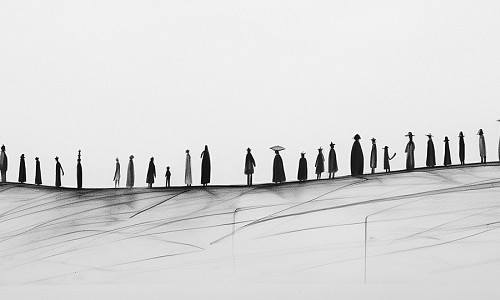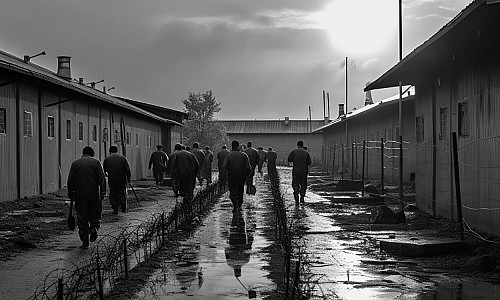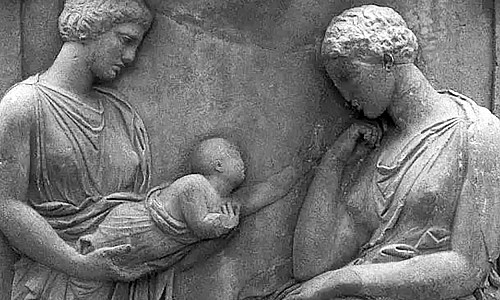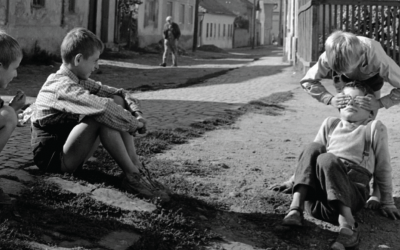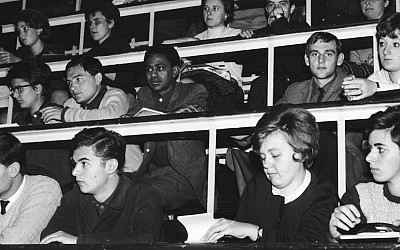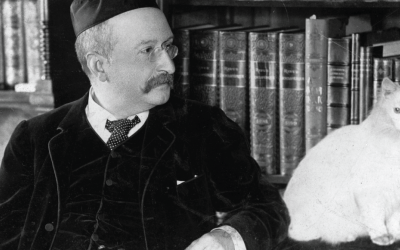Andrea Baldini considers the philosophical significance of elegance
“Are you going to a wedding after the conference?” When a young philosophy professor asked me this question, my reaction was one of true wonder, which Plato believed to be the beginning of philosophy. At that time, I was a graduate student just a few years younger than my interlocutor. His inquiry puzzled and perplexed me: I had no clear idea of how to respond. I struggled to find an answer. The suit and tie that I was wearing appeared to me as the appropriate – if not required – choice of clothing in a professional context. I grew up in Italy, the Mecca of male fashion, and there formal dress wear is not a rarity among men of all walks of life and age. But this was far from common practice at philosophy conferences in the US.
The question I was asked revealed more than the professor’s curiosity. The tone and gestures accompanying his words made obvious that he didn’t approve of my sense of style or my disposition to be dapper. The look in his eyes betrayed his disdain for fashion, which he considered a waste of time: “It is an unnecessary burden,” he confessed to me. He thought that it was something to avoid in the already packed schedule of a professor of philosophy. “No,” I rebutted gathering all the courage that as a graduate student I could find within myself, “as Oscar Wilde said, ‘A well-tied tie is the first serious step in life’ and I agree with him in a certain sense. Fashion is an important aspect of our lives. It defines us in many ways and is a rich source of daily aesthetic satisfaction.” I was trying to cast in philosophically acceptable jargon what had been until then two not-so-clear ideas in my mind – ideas that I still believe are correct and that I live by even today: fashion is an aesthetically rewarding part of our everyday lives and partly defines who we are.
That professor’s bias against fashion is hardly an exception in philosophical circles, and it is shared by many in the profession. This antipathy goes back a long way in the history of philosophy. It can already be seen in Socrates. Profoundly ugly, he had no regard for fashion and style, wearing the same dirty toga day and night. For Plato, Socrates’ disregard for his appearance became an image of the world’s metaphysics. Though ugly in his look, Socrates is exceptionally beautiful in his essence. In effect, for Plato, appearances are deceptive. Truth hides behind what we can see, and our journey towards knowledge is a process of unveiling. Søren Kierkegaard well expressed this connection between deception and clothing in a famous passage: “In order to swim one takes off all one’s clothes – in order to aspire to the truth one must undress in a far more inward sense, divest oneself of all one’s inward clothes, of thoughts, conceptions, selfishness, etc. before one is sufficiently naked.” If truth is naked, then, practices of clothing are intrinsically deceptive.
Philosophy turned its largely unwarranted suspicion towards fashion into silence. In effect, philosophers have ignored issues related to garments and attire. It is impossible to find any substantial philosophical work on these topics. Surprisingly enough, even aestheticians and philosophers of art – whose interests are inextricably intertwined with appearances and looks – haven’t made any serious contribution to the analysis of fashion and practices of clothing.
Immanuel Kant, founder of modern aesthetics, dismisses fashion with a quick comment in his Anthropology from a Pragmatic Point of View. He rejects the idea that fashion has anything to do with genuine judgements of taste: clothing choices depend on uncritical imitation, and therefore fall outside the scope of good taste, which tracks – among other things – originality. With a rejection from such an authority, it comes as no surprise that virtually no aesthetician after Kant accepted the challenge to rescue fashion from philosophical oblivion.
There is much to say against Kant’s quick dismissal of fashion as mere imitation. Whether Kant was correct about the fashion of his day (I doubt that), I leave it to historians to determine. But surely, he is mistaken when we consider much of today’s clothing practices, which not only allow for originality, but provide us with interesting artefacts for aesthetic enjoyment and help to give us a sense of identity. This is certainly clear in the world of contemporary menswear, which is the focus of this discussion.
Twenty-first century men’s fashion revolves around the notion of sprezzatura, which significantly informs our current understanding of elegance, grace, style, and good taste in fashion. The term became a staple of fashion discourse thanks to Renaissance author Baldassare Castiglione and his The Book of the Courtier, whose first edition was published in 1528. There, Castiglione signals as one of the main features of the perfect courtier what he called sprezzatura, which he defines as a certain kind of nonchalance aimed “to conceal all art and make whatever is done and said appear to be without effort and almost without any thought about it.”
As Eugenia Paulicelli well documents in Writing Fashion in Early Modern Italy: From Sprezzatura to Satire, the notion of sprezzatura has been absorbed in the jargon of contemporary men’s fashion, and is the driving force of the sartorialist movement. This trend is the Slow Food of fashion, opposing mass production of fast fashion while promoting sartorial craftsmanship as the preferred means to elegance and style.
Within this context, sprezzatura refers to two varieties of originality, one formal and the other performative, which conjointly rebuke Kant’s claim about fashion. They in turn also show the relationship connecting practices of clothing with good taste and the construction of one’s lifestyle. The implications at a theoretical level are relevant: contrary to their historical dismissal, the ways in which men can dress up are philosophically significant, and deserve a more sustained analysis.
As formal originality, sprezzatura refers to, as some has put it, “artful dishevelment” or imperfect elegance. In this sense, it then describes a particular style of putting together in a seemingly random way elements that at first sight appear incongruous or disharmonious, but that actually create an overall subtle and unique combination of distinct elegance. Men dressing with sprezzatura, therefore, mix clothes and accessories in ways that the canon characterises as fashion mistakes. But the formal arrangement of those parts presents itself as original, interesting to the eye, and a source of aesthetic satisfaction.
Gianni Agnelli, Italian business magnate, is a classic example of a man dressing with sprezzatura. This Godfather of style is considered one of the most elegant men of his generation, if not of all times. Agnelli was famous for wearing sartorial bespoke suits with touches of unconventional flair, while throwing in the mix unorthodox accessories. Some of his signature fashion moves could be mismatched for mistakes: actually, quite the contrary is true. They imbued Agnelli’s looks with originality and a pleasantly relaxed eye-catching style.
Perhaps the most iconic of Agnelli’s dressing choices was wearing his Cartier watch over the shirt’s cuff. Definitely unconventional and in principle a crass choice, this habit never looked out of place in Agnelli’s style, giving to his understated and sober elegance a touch of thrill. Other Agnelli’s style moves included wearing an off-kilter tie, tied in such a way that the back was longer than the front. This choice, of course, contradicted all rules of how to tie a tie, but it added to his calculated nonchalance that grounds formal originality.
“The Lawyer”, as he was nicknamed (despite never registering as one), was also often seen forgoing buttoning his button-down collar. In abstract, this would be generally considered a sign of sloppiness and stylistic negligence. And yet, this move allowed Agnelli’s collar and tie to pop-out just a bit, while subtly showing part of the buttons which appeared as some kind of jewels. At a younger age, “The Lawyer” was also photographed wearing a shirt collar outside a suit lapel – a more flamboyant and radical move that people would more likely associate with Agnelli’s own grandson and style guru Lapo Elkan. Lapo is also famous in fashion circles for wearing loafers with formal suits, another trend which was actually started once again by his grandfather. Agnelli also firstly introduced hiking boots as elements of a formal attire, adding new textures, materials, colours, and forms to the palette of the elegant man. His idiosyncratic fashion ticks made Agnelli’s style something intriguing and unique, far from a simple imitation of pre-established models.
To better appreciate the aesthetic merit of the formal originality that sprezzatura bring in fashion choices, let me quickly introduce a distinction recently developed by Yuriko Saito, whose work on everyday aesthetics is quite relevant to the present discussion. In “The Role of Imperfection in Everyday Aesthetics”, Saito distinguishes between aesthetic perfectionism and imperfectionism. Perfectionism considers perfection – broadly construed as lacking defects – as an aesthetic merit and its absence as a deficiency. Imperfectionism, on the contrary, rejects perfectionism and argues for the aesthetic worth of imperfection.
Saito offers a series of argument in favour of imperfectionism. Among them, the aesthetic argument maintains that imperfectionism enriches our aesthetic lives since it expands the range of features for appreciation. It does so by admitting irregular, disordered, and rough elements among those that are aesthetically rewarding. Moreover, Saito adds, imperfection stimulates to a greater degree our imagination. By following Joseph Addison’s characterisation of aesthetic experience as “the pleasure of the imagination”, Saito emphasises that the uncommon – not only the beautiful – engages our imagination and entertains our mind in always new and interesting ways.
With this argument in mind, one can better understand how and why formal originality brings aesthetic satisfaction. The uncanny accessories and unorthodox choices that men dressing with sprezzatura as Agnelli select, open up a range of possibilities for appreciation by allowing things such as hiking boots, unbuttoned buttons, raised collars, and watches to combine with more formal attires. These uncommon elements engage our imagination as we notice their unexpected presence. We do not get easily or immediately tired by their artfully disordered arrangement, which provides much stimuli to be entertained with. Just like Kant describes free natural beauty in the Critique of Judgement, formal originality offers us something “with which imagination can play in an unstudied and purposive manner [and is] always new to us, and one does not get tired of looking at it.”
In its second sense of performative originality, sprezzatura stresses the inseparable connection between dressing and “way of being”. The etymology of the Italian word abito, that is, “dress” in English, clearly reveals such an intimate link. Abito comes from the Latin habitus, a derivate of the verb habere whose primary meaning is “to behave”. As Castiglione remarked, sprezzatura is not just about what one wears, but also – and perhaps primarily – how one wears it. The answer, for contemporary sartorialists, is clear: a man of elegance wears his garments with nonchalance, confidence, and naturalness. Elegance does then not merely identify particular aesthetic features of an outfit, but also refers to a particular lifestyle: a way of behaving and acting in the world.
Performative originality that characterises elegant men is then close to a particular sense of authenticity that we find in the performing arts such as music, theatre, and cinema. We consider authentic those performances of musical players or actors that seem to be genuine instances of self-expression. What listeners find extraordinary in Glenn Gould’s legendary performances of Bach’s music is the (apparent) lack of artifice. Gould plays as if he were improvising in the moment, giving an illusion of constructed naturalness hiding decades of rigours training and controlled gestures. Actor Robert De Niro is famous for his meticulous preparation and rehearsal for his cinematographic roles. Directors working with him have praised his commitment admitting that everything that De Niro does on stage is fine-tuned and calculated. And yet, none of that preparatory work transpires in his performances, which appear on the contrary genuine and veritable: when watching him acting in Raging Bull, we have the impression of looking at the actual Jack LaMotta, not at someone pretending to be him. In other words, authentic performances make us forget that the musician is reading a score or the actor a script, but make us feel as if those performers were creating something original on the spot. In fashion being original in a performative sense is to behave in ways that look and feel genuine and spontaneous, even if they are intensely pondered.
Elegant men then take their performative originality not only from the suit, the tie or the shoes that they wear. They also get it from how they wear them: how they move, walk, and talk while dressed in that particular way. For this very reason, style gurus warn novices about the dangers and potential pitfalls of unexperienced attempts at sprezzatura. It is not enough to imitate Agnelli’s style to be elegant. Simply wearing a watch over the cuff or leaving unbuttoned one’s button-down collar do not necessarily result in a look of good taste. Very often, it achieves exactly the opposite: bad taste and crass look. Failure awaits the man who lacks the appropriate attitude and behaviour, the needed nonchalance in wearing that particular outfit. Elegance emerges from uncanny fashion moves when they appear as self-originating, that is, when they look and feel natural and authentic for the wearer.
Here we find explained the other significant aspect of fashion, which is not just an aesthetically rewarding practice of the everyday, but also an activity whereby we define and redefine who we are and our place in the world. Choosing a certain outfit and pairing it with unexpected accessories – playing with colours, textures, and patterns – is not merely a matter of looking in a particular way. It is also a matter of being a certain person, whose identity is partly defined by the wardrobe choices that one makes.
Considered from this point of view, performative originality is then a form of performativity of the subject in a sense that echoes Judith Butler’s discussion of gender and identity. Butler criticises the essentialist view of gender, and refuses to accept that there is some shared set of properties that would allow for a definition of identity categories such as “women” and “men”. In her view, there are not such properties, and – for instance – women qua women are not bearers of common traits and attributes given and fixed at birth. On the contrary, identity categories are social constructs, singling out accidental features which make up, among other things, one’s gender.
The constitution of such categories, Butler suggests us, and one’s inclusion in a particular group depend on a series of performative actions. Gender, in this sense, is not a matter of what one is, but of what one does in the world. Through performances, we negotiate and renegotiate our sexual identity. Fashion is, of course, one of those performances whereby individuals can do such a thing. It is not an accident that Butler discusses at length cross-dressing in her analysis of systems of identity construction. Of course, there is more to identity construction than gender: race and class, among others, play also a crucial role. And male fashion – and fashion more in general – enters into the constitution of our individuality in this more global sense. By performing in a certain way, the stylish man does not simply represent himself, but constitutes his own identity. The path to elegance, to sprezzatura, is therefore a path of self-creation.
Perhaps it is in the light of this last insight that we should read the following remark of Oscar Wilde, the intellectual who more than any other understood the philosophical relevance of fashion: “It is only shallow people who do not judge by appearances. The true mystery of the world is the visible, not the invisible.” Let Socrates keep his dirty toga. Give me the shiniest silk.
Andrea Baldini is associate professor of aesthetics and art theory at the Art Institute of Nanjing University in China. He loves Prince of Wales check suits, outrageously colourful silk ties, and loafers of all shapes and designs.
You might also like...




